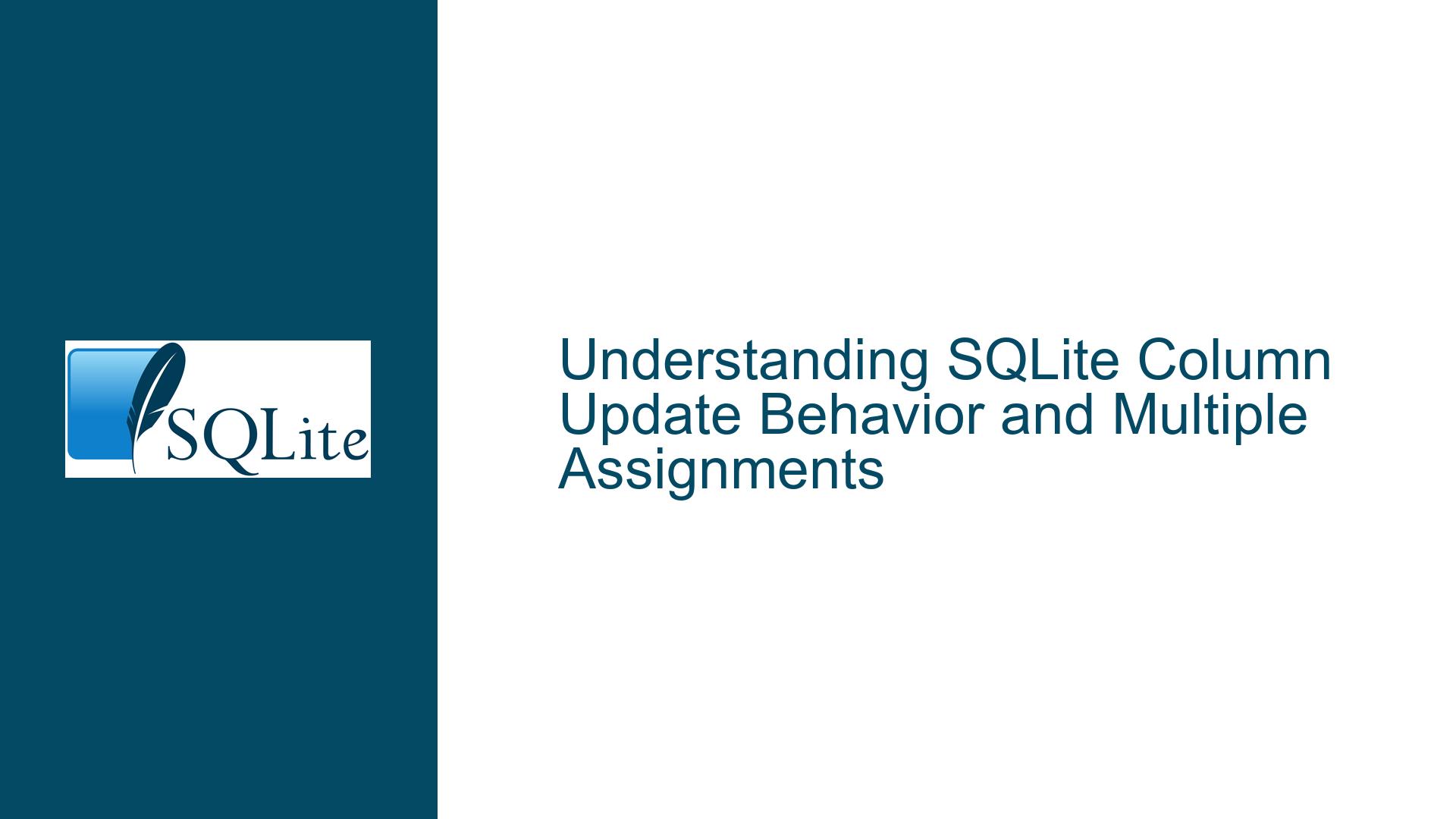SQLite Column Update Behavior and Multiple Assignments
SQLite’s Handling of Multiple Column Updates in a Single Statement
SQLite, unlike some other relational database management systems (RDBMS), allows for a unique behavior when updating columns within a single UPDATE statement. Specifically, SQLite permits multiple assignments to the same column within a single UPDATE statement, which can lead to unexpected results if not properly understood. This behavior is not inherently wrong, but it diverges from the stricter enforcement seen in databases like MSSQL or Firebird, which explicitly prohibit multiple assignments to the same column in a single UPDATE statement.
In SQLite, when you write an UPDATE statement such as:
UPDATE T SET
A = A + 1,
A = A + 1;
SQLite processes each assignment sequentially. The final value of column A will be determined by the last assignment in the statement. In this case, A will be incremented by 1 twice, resulting in a net increase of 2. However, this behavior can be counterintuitive, especially for developers accustomed to databases that enforce stricter rules.
Similarly, consider the following example:
UPDATE T SET
A = A + 1,
A = A - 1;
Here, the final value of A will be its original value because the increment and decrement cancel each other out. This sequential processing is a key feature of SQLite’s update mechanism, but it can lead to confusion if the developer expects the database to enforce a single assignment per column.
Another example involves swapping values between columns:
UPDATE T SET
F1 = F2,
F2 = F3,
F3 = F4,
F4 = NULL;
In this case, SQLite processes each assignment in the order they are written. The value of F1 is set to the original value of F2, F2 is set to the original value of F3, and so on. This behavior is consistent and reliable within SQLite, but it is crucial to understand that the assignments are processed sequentially, and the final values are determined by the order of the assignments.
Sequential Processing and the SQL Standard
The behavior described above raises questions about whether this sequential processing of column updates is defined by the SQL standard. The SQL standard does not explicitly mandate how databases should handle multiple assignments to the same column within a single UPDATE statement. This lack of specificity allows different databases to implement their own rules, leading to the divergence seen between SQLite and databases like MSSQL or Firebird.
In MSSQL, for example, attempting to update the same column multiple times in a single UPDATE statement results in an error:
UPDATE T SET
A = A + 1,
A = A + 1;
This would trigger an error message stating that the column ‘A’ is specified more than once in the SET clause. MSSQL enforces a strict rule that a column can only be updated once per UPDATE statement. Similarly, Firebird SQL also prohibits multiple assignments to the same column, generating an error message that explicitly states the column cannot be repeated in the update statement.
SQLite, on the other hand, does not enforce this restriction. Instead, it processes each assignment sequentially, applying the changes in the order they are written. This behavior can be advantageous in certain scenarios, such as when you need to perform complex updates that involve multiple steps. However, it also requires a deeper understanding of how SQLite processes these updates to avoid unintended results.
Ensuring Predictable Column Updates in SQLite
To ensure predictable and reliable behavior when updating columns in SQLite, it is essential to understand the order in which assignments are processed and to structure your UPDATE statements accordingly. Here are some key considerations and best practices:
Sequential Assignment Order: Always remember that SQLite processes assignments in the order they are written. The final value of a column will be determined by the last assignment that references it. For example:
UPDATE T SET A = A + 1, A = A - 1;In this case, the final value of
Awill be its original value because the increment and decrement cancel each other out.Swapping Values Between Columns: When swapping values between columns, ensure that the assignments are ordered correctly. For example:
UPDATE T SET F1 = F2, F2 = F3, F3 = F4, F4 = NULL;This statement will correctly shift values from
F2toF1,F3toF2, andF4toF3, while settingF4toNULL.Avoiding Unintended Side Effects: Be cautious when updating multiple columns in a single statement, especially when the same column is referenced multiple times. For example:
UPDATE T SET A = B, B = A;This statement will swap the values of
AandB, but it relies on the sequential processing of assignments. If the order of assignments is changed, the result will be different.Testing and Validation: Always test your
UPDATEstatements thoroughly, especially when dealing with complex updates that involve multiple columns or multiple assignments to the same column. Use transactions to ensure that you can roll back changes if the results are not as expected.Documentation and Code Comments: Clearly document the intended behavior of your
UPDATEstatements, especially when they involve complex logic or multiple assignments. This will help other developers understand the code and avoid introducing errors when making changes.
By following these best practices, you can ensure that your UPDATE statements in SQLite behave predictably and reliably, even when dealing with complex updates that involve multiple columns or multiple assignments to the same column.
Advanced Techniques for Complex Updates
In some cases, you may need to perform complex updates that go beyond simple column assignments. SQLite’s flexibility allows for advanced techniques that can handle these scenarios effectively. Here are some examples:
Conditional Updates: You can use
CASEstatements within yourUPDATEstatements to perform conditional updates. For example:UPDATE T SET A = CASE WHEN B > 10 THEN A + 1 ELSE A - 1 END;This statement increments
Aby 1 ifBis greater than 10, otherwise, it decrementsAby 1.Updating Multiple Columns Based on a Condition: You can update multiple columns based on a single condition. For example:
UPDATE T SET A = CASE WHEN B > 10 THEN A + 1 ELSE A - 1 END, C = CASE WHEN B > 10 THEN C + 1 ELSE C - 1 END;This statement updates both
AandCbased on the value ofB.Using Subqueries in Updates: You can use subqueries within your
UPDATEstatements to update columns based on values from other tables or complex calculations. For example:UPDATE T SET A = (SELECT SUM(B) FROM T2 WHERE T2.id = T.id);This statement updates column
Ain tableTwith the sum of columnBfrom tableT2where theidvalues match.Updating with Joins: Although SQLite does not support
JOINsyntax directly inUPDATEstatements, you can achieve similar results using subqueries or correlated updates. For example:UPDATE T SET A = (SELECT B FROM T2 WHERE T2.id = T.id);This statement updates column
Ain tableTwith the value of columnBfrom tableT2where theidvalues match.
By leveraging these advanced techniques, you can handle complex update scenarios in SQLite with confidence, ensuring that your database operations are both efficient and reliable.
Conclusion
SQLite’s handling of multiple column updates in a single UPDATE statement offers a level of flexibility that can be both powerful and potentially confusing. By understanding the sequential nature of these updates and following best practices, you can ensure that your UPDATE statements behave predictably and reliably. Whether you’re performing simple column updates or complex conditional updates, SQLite provides the tools you need to manage your data effectively. Always remember to test your statements thoroughly and document your code to avoid unintended side effects and ensure maintainability.






